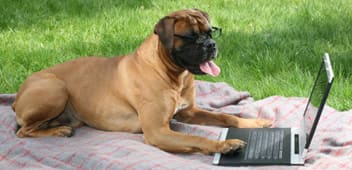Rocky’s Viewpoint

My dog Yankee has walked all of his life in what’s called a “pace” gait. Unlike a standard gait where a dog’s diagonal legs move at the same time, a pace gate is where both limbs on the same side move forward and backward at the same time.
Thanks to DogTread, here’s a short video to show what I mean by a pace gait.
While some breeds such as Old English Sheepdogs, English Springer Spaniels, Neapolitan Mastiffs and some herding breeds are predisposed to a pace gait, for most breeds this is considered abnormal. Why do dogs adopt this walking pattern? There are varied reasons including their conformation (which I think is the reason Yankee paces), age, weight, fatigue or injury. Sometimes laziness is the reason, especially if the dog is not in good physical condition. Another possible reason is that the dog is trying to match the owner’s gait. In all these cases, the dog compensates by pacing. Why is this bad? Because pace gaits create muscle imbalances that can lead to injury or pain, and more pacing.
If your dog suddenly begins pacing after walking in a normal pattern for years, it may indicate a problem. The problem may be as simple as fatigue, but it can also be a sign of a more serious issue. Your dog could be in pain, have an injury or some sort of physical degeneration, or have a structural or neurological dysfunction.
If you notice that your dog has begun pacing, you should see your veterinarian to find out if there’s a reason other than fatigue. Once you find the cause, you may also want to visit a veterinary chiropractor, and consider massage as a way of helping muscles return to normal balance. Aqua therapy can help retrain muscles because dogs generally swim by moving their legs diagonally as in a standard gait.
If the dog is able, walking on a treadmill is also a great way to retrain muscles to move in a normal pattern. In fact, this is one of the ways I’m working with Yankee. I know it works because I see him resorting less and less to his pace gait. If your dog has a pace gait, let us take a look at him or her. We’d be happy to help.